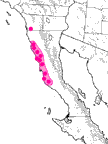


| Description | Distribution | Discussion | Horticultural Notes | Nomenclature | Cited Literature | Links |

| 
|  |
| plants forming extensive thickets | small deeply cut leaves | prominent prickles, prickly-hispid hip |

| West coast of Baja California Norte, Mexico, and on the Otay Mesa in San Diego Co., California, USA. The species is a common constituent of the coastal scrub community in northern Baja California, extending from near Ensenada to somewhere south of El Rosaria, and inland to the south end of the Sierra San Miguel in central Baja California. The disjunct population from San Diego County, the only one known in the United States, is of conservation concern.
Additional distributional representations available from links at entry for this species in the Jepson Interchange for On-Line Floristics |
The history of Discovery of Rosa minutifolia is a story in its own right, called by Lenz (1982) the Thorny Rose Affair.
Lenz, Lee W. 1982. The thorny rose affair: discovery and naming of Rosa minutifolia. Aliso 10:187--217.
Rydberg, Per Axel. 1918. Rosa. North American Flora 22(6): 483--533.